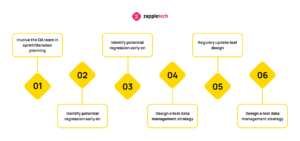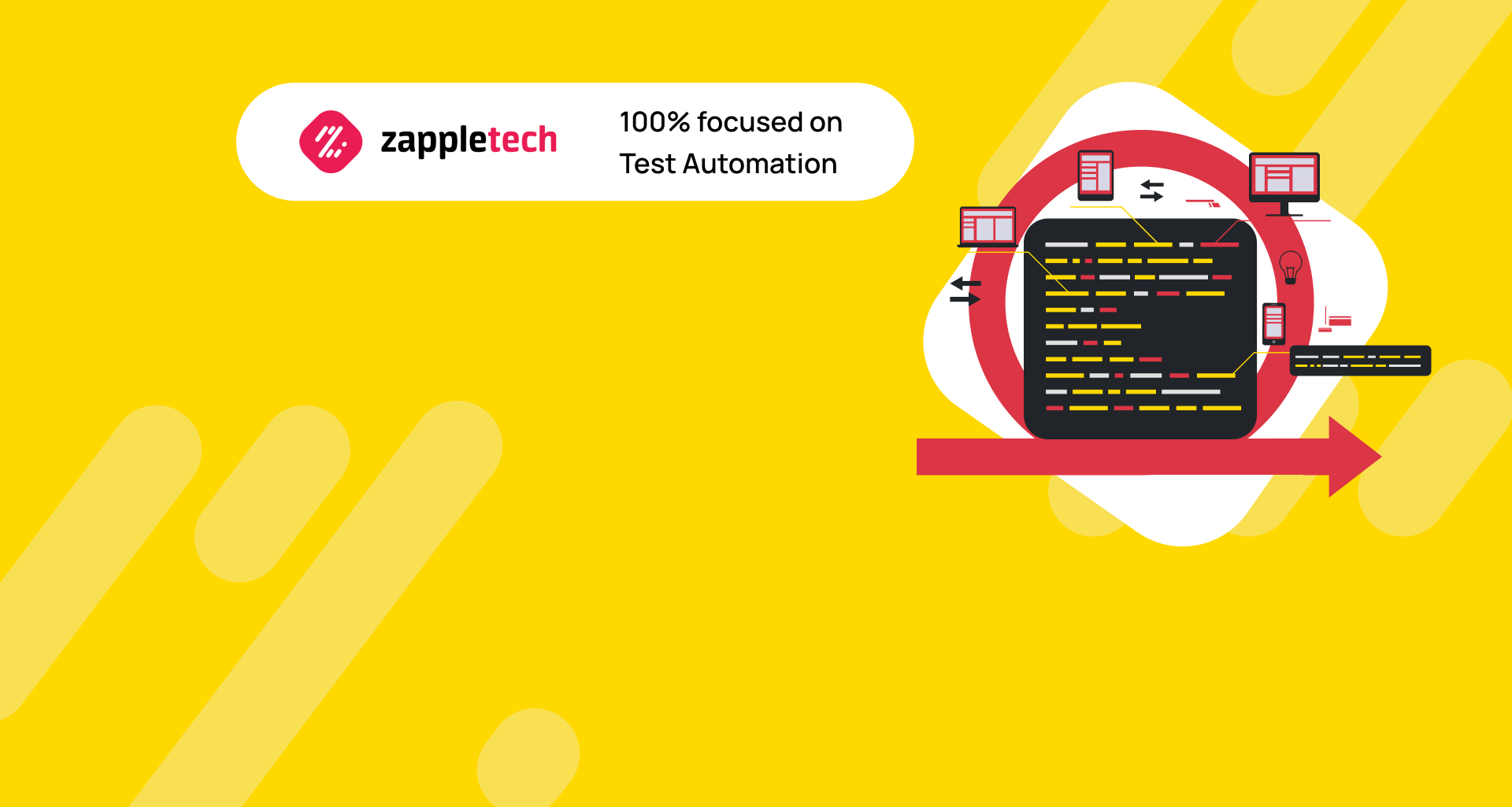In-sprint test automation is widely used in Agile and DevOps methodologies. With a competent approach, it comprehensively checks functional elements and ready-made code blocks but does not cope with the task when the changes are made to the product during the sprint. Although it is an obvious drawback, it is solvable. ZappleTech specialists investigated problems in standard automation methods and provided solutions to some of them based on the results.
Ensure open communication between developers, testers, and product owners. Regularly sync up to align on goals and address any challenges that arise in your in-sprint test automation efforts.Sergey AlmyashevCOO, ZappleTech Inc.
In Agile and DevOps practices, in sprint test automation and in sprint automation streamline testing processes, ensuring that testing keeps pace with rapid development cycles. However, traditional automation tools often fall short when new changes are introduced mid-sprint, leading to gaps in test coverage and potential issues slipping through the cracks. ZappleTech has addressed these challenges by refining its approach and incorporating adaptive strategies that can handle real-time changes efficiently. By enhancing in sprint automation techniques, they ensure more robust and reliable testing throughout the development cycle.
Furthermore, ZappleTech’s innovative solutions include integrating AI-driven test scripts that automatically adjust to code changes, minimizing manual intervention. Their continuous feedback loop allows for rapid identification and resolution of defects, ensuring higher quality and faster delivery times. Additionally, their approach emphasizes collaboration between developers and testers, fostering a culture where quality is a shared responsibility.
By implementing these advanced in sprint test automation practices, ZappleTech has significantly improved the effectiveness of test automation. This not only reduces the risk of defects reaching production but also accelerates the development process, enabling teams to deliver high-quality products more efficiently. As Agile and DevOps methodologies continue to evolve, the importance of adaptive and responsive in sprint automation becomes increasingly critical, positioning ZappleTech at the forefront of innovative testing solutions.
Table of Contents
What is AT in the IT industry: efficiency without barriers

It’s been 50 years since IT specialists made their first attempts to create an advanced and logical model for developing digital products. During this time, methods like Waterfall, V, Incremental, RAD, Agile, Iterative, or Spiral were introduced more or less successfully. Each has pros and cons, but their main difference lies in product implementation and the philosophy of creating IT solutions.
Now the popular model for managing project roadmaps is Agile, which means “flexible, changeable, adaptable.” On its basis, the equally popular Scrum was created, distinguished by scaling and integrating several teams into one project. This approach facilitates in sprint test automation and in sprint automation, ensuring that testing and development processes are streamlined within the sprint cycle. Another example of Agile’s success is DevOps, which incorporates the best practices of its ancestor but offers a fundamentally new way of working. Unfortunately, according to BMC, it causes difficulties for 50% of those who want to implement it.
By adopting Agile methodologies, including in sprint test automation and in sprint automation, teams can respond more swiftly to changes, delivering high-quality digital products more efficiently. These practices help in detecting and fixing bugs early, reducing the risk of significant issues in later stages of development. In sprint test automation ensures continuous testing throughout the development process, providing immediate feedback and allowing for quick adjustments.
Moreover, in sprint automation supports the Agile principle of iterative progress by automating repetitive tasks and processes, freeing up developers to focus on more complex and creative aspects of the project. This not only accelerates the development cycle but also enhances the overall quality of the product.
The integration of in sprint test automation and in sprint automation within Agile frameworks like Scrum and DevOps is becoming increasingly critical in today’s fast-paced IT environment. As businesses strive to stay competitive, the ability to deliver reliable and high-performing software swiftly is paramount. These methodologies offer a robust foundation for achieving such goals, making them indispensable tools for modern IT teams.
In conclusion, the evolution of software development methodologies over the past 50 years has led to the creation of advanced frameworks like Agile, which emphasize flexibility and adaptability. The incorporation of in sprint test automation and in sprint automation within these frameworks enhances their effectiveness, enabling teams to produce high-quality digital products efficiently and responsively. As the industry continues to evolve, these practices will undoubtedly remain at the forefront of successful software development strategies.
The DevOps philosophy implies involving in the project team the performers and the leader as well as the customer. What does it mean for developers?
- A clear understanding of the ToR and key requirements.
- Control over the work and timely edits.
- Reduced reporting chain and optimized communication.
- Better workflow of people involved in the project.
How it looks in practice:
- Planning stage: developing a layout and approving it by the employer.
- Writing scripts to check the viability of individual elements. Creating a project’s roadmap.
- Dividing the project into parts called sprints (usually about two weeks each).
- Start of development.
- Reporting on the work performed.
- The team meets (sometimes remotely) and discusses progress.
- The sprint continues.
In-sprint test automation: efficiency and stability
Why does ZappleTech focus on two of the most popular methods? They most often use automatic detection of bugs in each cycle of product development. We mainly work according to the DevOps and Agile models, so we know everything about their advantages and disadvantages. Yes, it is a complex process that requires high skills for both QA and programmers. With the help of AT, the human factor is minimized, and each critical element is checked in various scenarios. Additionally, in sprint test automation can loop indefinitely, checking the function for robustness and random bugs.
Begin with automating a few critical tests and gradually expand your coverage. This allows your team to adapt and refine the process without overwhelming them.Mikhail BodnarchukCDO, ZappleTech Inc.
In-sprint test automation ensures that each sprint’s objectives are met without delays caused by undetected issues. This method integrates seamlessly with our DevOps and Agile practices, allowing for continuous testing and immediate feedback. By implementing in sprint automation, ZappleTech maintains high standards of software quality and performance, ensuring stability throughout the development lifecycle.
Our approach to in sprint test automation not only enhances efficiency but also supports rapid development cycles. It enables our team to identify and address potential issues early, reducing the time spent on debugging and rework. The consistent application of in sprint automation leads to more reliable releases and a faster time-to-market for our clients’ products.
In conclusion, ZappleTech’s dedication to in sprint test automation and in sprint automation is driven by our commitment to delivering robust, high-quality software solutions. This approach helps us maintain efficiency, stability, and excellence in every project we undertake.
In-sprint automation: challenges for QA and solving emerging problems
The main problem of agile methods is the lack of a clear understanding of the final result in the first cycles. While the Waterfall model had an organic structure with a linear work plan, with Agile, the team must adapt to an ever-changing schedule. This does not cause problems in manual testing, but in the case of in sprint test automation, constant adjustments can be challenging.
Addressing In-Sprint Automation Challenges
Why does ZappleTech focus on two of the most popular methods? They most often use automatic detection of bugs in each cycle of product development. We mainly work according to the DevOps and Agile models, so we know everything about their advantages and disadvantages. Yes, it is a complex process that requires high skills for both QA and programmers. With the help of AT, the human factor is minimized, and each critical element is checked in various scenarios. Additionally, in sprint test automation can loop indefinitely, checking the function for robustness and random bugs.
In-sprint test automation ensures that each sprint’s objectives are met without delays caused by undetected issues. This method integrates seamlessly with our DevOps and Agile practices, allowing for continuous testing and immediate feedback. By implementing in sprint automation, ZappleTech maintains high standards of software quality and performance, ensuring stability throughout the development lifecycle.
The Importance of Adaptability
Our approach to in sprint test automation not only enhances efficiency but also supports rapid development cycles. It enables our team to identify and address potential issues early, reducing the time spent on debugging and rework. The consistent application of in sprint automation leads to more reliable releases and a faster time-to-market for our clients’ products.
Solving Emerging Problems
One of the key challenges in in-sprint automation is maintaining the flexibility required to adapt to Agile’s dynamic environment. ZappleTech addresses this by continuously refining our test automation frameworks to accommodate changes in requirements and priorities. This ensures that our in sprint test automation processes remain effective even as project scopes evolve.
In conclusion, ZappleTech’s dedication to in sprint test automation and in sprint automation is driven by our commitment to delivering robust, high-quality software solutions. This approach helps us maintain efficiency, stability, and excellence in every project we undertake.
Planning and DevOps
Why is it necessary to keep in touch with the customer at every stage of product creation? Usually, customers do not understand product needs, so they make edits during work. The priorities change weekly, forcing IT specialists to change the vector on the run and adapt to new tasks. The QA team also has a hard time because in-sprint automation is not easy to rewrite for a new scenario.
Solution: Join the daily/weekly discussion between the client and the lead project. Constant communication relieves the team from worries during the sprint, as there is no need to edit cases and tools. Also, it is easier to make reports at the end of each cycle if all participants are aware of the results of the company’s departments.
Creating test cases and defining a scenario
Unlike manual, in-sprint test automation requires careful preparation before launching. Since you need to test both the values and the interface, writing cases and scenarios is delayed, leaving less time for testing. As a result, some elements are ignored for the sake of priority goals.
Solution: start preparing for in-sprint automation at the very beginning of each cycle. Make an example of a scenario and add tasks gradually. This process should take no more than ⅔ of a sprint so that the automated test has time to check all vital blocks before the end of the sprint.
Backtesting
Each development cycle ends with the introduction of a new feature of the road map. Of course, when writing and editing code, some of the old blocks may change. Regression testing is used to check the performance of all elements. Manual checking takes a lot of time, distracting QA from current tasks. The most logical way is to automate this process and run it simultaneously with in-sprint test automation.
Solution: at the beginning of the sprint or between them, adjust the early scenarios and include the changed pieces of the product in the cases. Thus, you introduce simultaneous testing of the previous and current functionality. It is a vital part of successful in-sprint automation.
Test Objectives: Priorities and Ignore Sheets
Firstly, identify priority tasks. As a rule, development begins with critical project functions: design, CMS, CRM, and programming the product base. Start checking with them because additional modules like payment systems and integration with social networks are better to implement on late pre-release stages.
Solution: Develop a test roadmap before the start of the sprints. Involving the customer in this process reduces edits and does not shift priorities. For successful automation, it is important to have a complete understanding of the work of each link of an IT company.
Optimization of the in-sprint test automation structure
The clearer and simpler the code, the easier it is for both machines and the developers to perceive it. The situation is similar in testing. The priorities must be determining the relationships between design, front-end, and back-end components, describing them in cases, and structuring them in the test scenarios. Otherwise, the probability of an error will be extremely high.
Solution: development of the layout before starting work. The main reference point should be proposed scenarios of usage. The visualized blocks with links help to define the necessary mechanics of in-sprint test automation more accurately.
Information and Working Methods
It happens that a developer or QA specialist suddenly leaves the project during a sprint or in between development cycles. The problem arises when an outside IT specialist comes and continues the work of this employee. Programmers and testers write cases and code in their unique styles, which sometimes are not understandable even to experienced colleagues. As a result, you have to start all over again or waste time trying to understand how it works.
Solution: before the employee leaves, ask him to leave notes on the work performed or train the new specialist. It will save time for the whole team.
How to simplify the life of a QA specialist
To optimize in-sprint test automation, you need to:
- Involve programmers, testers, a leader, and a customer in the development and make them work together.
- Think over a work plan, draw up a roadmap, and break the project into sprints.
- Create cases in the first days of the next cycle and configure scenarios.
- Improve the tool and design gradually.
- Start AT and check its operation.
- Edit scenarios and re-enable the test.
- Analyze the results and generate a report.
- Get a bonus for found bugs.
We are well aware that the threshold for entering in-sprint test automation is very high, and the results will be very mediocre without a decent background. If you need additional advice or professional help, feel free to contact ZappleTech! The company’s managers will provide information and offer high-quality QA in a short time!
Conclusion
Successfully implementing in sprint test automation requires a well-thought-out strategy, a collaborative team effort, and the right set of tools and practices. By integrating testing into the development process, teams can catch defects early, reduce technical debt, and ensure that the product quality remains high throughout the sprint.
Engaging developers, testers, and product owners in planning sessions ensures that everyone understands the scope and objectives of in sprint test automation. Clear communication and shared goals are crucial for seamless integration. Choosing the right automation tools that align with your development environment and team’s expertise is also essential. Tools like Selenium, TestNG, or JUnit can be integrated into CI/CD pipelines to facilitate continuous testing and feedback.
Choose automation tools that integrate seamlessly with your development environment. This reduces friction and helps maintain the efficiency and effectiveness of your in-sprint automation process.Mykhailo PoliarushCEO, ZappleTech Inc.
Starting with automating the most critical tests and gradually expanding coverage helps manage the complexity and ensures a smooth transition to in sprint automation. Continuous monitoring and adjusting the test suite to address new challenges and requirements are necessary to maintain its effectiveness.
Moreover, fostering a culture of collaboration and continuous improvement within the team can significantly enhance the success of in-sprint test automation. Regularly reviewing and refining the process, based on feedback and results, leads to better outcomes and higher efficiency.
In conclusion, mastering in sprint test automation involves meticulous planning, the right tools, and a collaborative approach. By embedding in sprint automation into the sprint cycle, teams can achieve faster delivery, higher quality, and greater agility, ultimately leading to more successful project outcomes.







